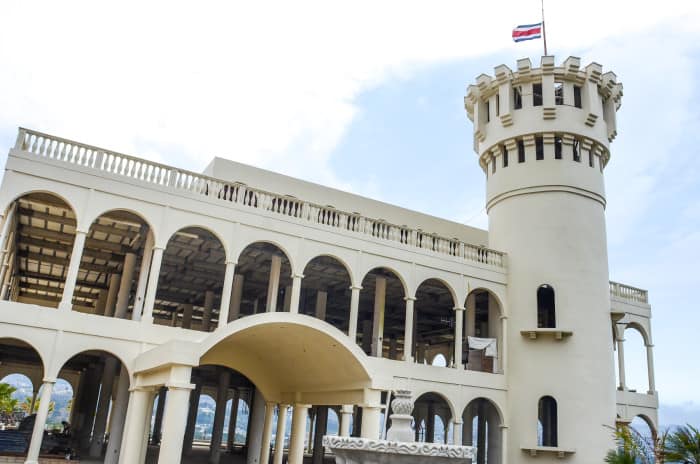SAN FRANCISCO, Cartago — It was the hottest tourist attraction in Costa Rica in the 1880s — an “extremely hot” spring with a centuries-old reputation as a “fountain of youth,” visited by European aristocrats and renowned for its healing powers.
The elegant Bella Vista Hotel opened in 1885 to provide access to these curative waters, which were said to be superior to those of the best spas in Europe and the U.S. But times changed, and the Bella Vista closed its doors before the devastating 1910 earthquake that destroyed most of Cartago, the reason that is usually cited for its closure.

The springs fell into disuse and ended up lost, forgotten and buried in a garbage dump for decades — until a somewhat obsessed Israeli adventurer named Avraham Kotlitzky came here eight years ago, moved garbage and weeds aside and thrust his hand into a hot spring.
“I do a lot of things in my life, but for me the most important thing I do is this place,” Kotlitzky said during an interview and rare tour of the Palacio Purapora, the giant resort he is building just south of Cartago on the hill where the dump used to be. “This water is going to give big hope for people, and the people need it.”

Formerly a banquet hall owner in Israel, Kotlitzky began his Costa Rica quest when he saw an old photo of the Bella Vista Hotel and springs. He asked people where this beautiful place was, and someone recalled that it had been in Cartago. He went there and searched, and he found the spring under some weeds and rotting boards.
The “palace” he is building here now is five stories high, counting the turreted tower flying the flag of Costa Rica, and it looks like something out of another age. The arches are said to resemble Roman or Middle Eastern styles (and to some extent the design of the old Bella Vista Hotel), while the tower was inspired by the architecture of the National Museum of Costa Rica.
The Purapora Palace will have some 40 suites, a restaurant, a bar and plenty of hot pools.

Kotlitzky, who has huge vision and limited English, struggled to explain why he wanted to build such a large structure above the ancient springs he rediscovered.
“These questions I ask myself all day. Why me? All day,” he said. “Hey God, why, what are you doing with me? Why did you change my life?”
Eduardo Chaves, 32, Purapora’s sculptor, muralist and designer, said for Kotlitzky this is not a for-profit venture but a higher mission.

“He sees it as his life’s destiny,” he said. “It’s something very personal. … When Avraham came here, he didn’t just want to build the big building for access to the springs, but he also wanted to recreate history. The history of the waters, that’s what he wants to bring back to life.”
Kotlitzky emphasized that he and his hotel are not the story here — the water is.

With clear-eyed certainty, Kotlitzky said soaking in the water here can effectively treat or cure psoriasis, seborrhea, rheumatism, arthritis and a great many other ills. Drinking the water, he said — and it has been certified potable — can cure all kinds of stomach problems.
“For stress, this water is the best,” he said. “This water is a miracle.”

Two visitors from The Tico Times got a chance to soak in (and taste) the steaming water pumped into a variety of elegant tubs and showers in the heart of this complex. It was, as described in a 1933 tour book, “extremely hot” — the temperature of the water reaches 55 degrees Celsius, 131 Fahrenheit.
It tasted faintly like Alka-Seltzer. The water smells of sulfur, but the odor is not very strong.
So when will all of this be open to the public? It’s a question a lot of curious neighbors have been asking.

“Soon, like one year,” Kotlitzkly predicted — an optimistic assertion considering the deliberate pace at which he works.
“We are working eight years here, eight years, slowly, slowly, slowly, slowly, but we are working,” he said.

The name Purapora comes from the indigenous Huetar ceremonial capital, said to have been founded here because of the hot springs, and Huetar artwork inspires the murals and statues that decorate the gardens.
Juan Vásquez de Coronado, the Spanish conquistador who in 1563 founded Cartago, Costa Rica’s first capital, was said to have chosen the spot because he believed he had found the “fountain of eternal youth.”

In the 1780s, reports of the springs’ restorative powers led governor Juan Flores to build a bridge, house, wall and other improvements to facilitate access to these healing springs.
A century later, the Bella Vista Hotel was open for business and hosting such dignitaries as the brother of the Belgian King Leopold II.

Now it’s Kotlitzky’s turn to live up to the storied history of this place.
“He has a lot of money, but he has his businesses in Israel,” Chaves said. “He has no other projects here. And this project, he sees it like a mission from God.”
–
Contact Karl Kahler at kkahler@ticotimes.net.






